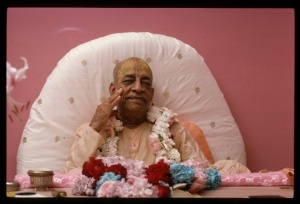CC Madhya 23.117-118: Difference between revisions
No edit summary |
(Vanibot #0054 edit - transform synonyms into clickable links, which search similar occurrences) |
||
| Line 19: | Line 19: | ||
<div class="synonyms"> | <div class="synonyms"> | ||
''mauṣala-līlā'' | ''[//vanipedia.org/wiki/Special:VaniSearch?s=mauṣala&tab=syno_o&ds=1 mauṣala]-[//vanipedia.org/wiki/Special:VaniSearch?s=līlā&tab=syno_o&ds=1 līlā]'' — the pastimes of destroying the Yadu dynasty; ''[//vanipedia.org/wiki/Special:VaniSearch?s=āra&tab=syno_o&ds=1 āra]'' — also; ''[//vanipedia.org/wiki/Special:VaniSearch?s=kṛṣṇa&tab=syno_o&ds=1 kṛṣṇa]-[//vanipedia.org/wiki/Special:VaniSearch?s=antardhāna&tab=syno_o&ds=1 antardhāna]'' — the disappearance of Kṛṣṇa; ''[//vanipedia.org/wiki/Special:VaniSearch?s=keśa&tab=syno_o&ds=1 keśa]-[//vanipedia.org/wiki/Special:VaniSearch?s=avatāra&tab=syno_o&ds=1 avatāra]'' — the incarnation of the hairs; ''[//vanipedia.org/wiki/Special:VaniSearch?s=āra&tab=syno_o&ds=1 āra]'' — also; ''[//vanipedia.org/wiki/Special:VaniSearch?s=yata&tab=syno_o&ds=1 yata]'' — all; ''[//vanipedia.org/wiki/Special:VaniSearch?s=viruddha&tab=syno_o&ds=1 viruddha] [//vanipedia.org/wiki/Special:VaniSearch?s=vyākhyāna&tab=syno_o&ds=1 vyākhyāna]'' — statements against the Kṛṣṇa conscious conclusions; ''[//vanipedia.org/wiki/Special:VaniSearch?s=mahiṣī&tab=syno_o&ds=1 mahiṣī]-[//vanipedia.org/wiki/Special:VaniSearch?s=haraṇa&tab=syno_o&ds=1 haraṇa]'' — kidnapping of the queens; ''[//vanipedia.org/wiki/Special:VaniSearch?s=ādi&tab=syno_o&ds=1 ādi]'' — and so on; ''[//vanipedia.org/wiki/Special:VaniSearch?s=saba&tab=syno_o&ds=1 saba]'' — all; ''[//vanipedia.org/wiki/Special:VaniSearch?s=māyā&tab=syno_o&ds=1 māyā]-[//vanipedia.org/wiki/Special:VaniSearch?s=maya&tab=syno_o&ds=1 maya]'' — made of the external energy; ''[//vanipedia.org/wiki/Special:VaniSearch?s=vyākhyā&tab=syno_o&ds=1 vyākhyā]'' — explanations (countering the attack of the ''asuras''); ''[//vanipedia.org/wiki/Special:VaniSearch?s=śikhāila&tab=syno_o&ds=1 śikhāila]'' — instructed; ''[//vanipedia.org/wiki/Special:VaniSearch?s=yaiche&tab=syno_o&ds=1 yaiche]'' — which; ''[//vanipedia.org/wiki/Special:VaniSearch?s=su&tab=syno_o&ds=1 su]-[//vanipedia.org/wiki/Special:VaniSearch?s=siddhānta&tab=syno_o&ds=1 siddhānta]'' — proper ''conclusions''; ''[//vanipedia.org/wiki/Special:VaniSearch?s=haya&tab=syno_o&ds=1 haya]'' — are. | ||
</div> | </div> | ||
Latest revision as of 22:57, 19 February 2024

A.C. Bhaktivedanta Swami Prabhupada
TEXTS 117-118
- mauṣala-līlā, āra kṛṣṇa-antardhāna
- keśāvatāra, āra yata viruddha vyākhyāna
- mahiṣī-haraṇa ādi, saba—māyāmaya
- vyākhyā śikhāila yaiche susiddhānta haya
SYNONYMS
mauṣala-līlā — the pastimes of destroying the Yadu dynasty; āra — also; kṛṣṇa-antardhāna — the disappearance of Kṛṣṇa; keśa-avatāra — the incarnation of the hairs; āra — also; yata — all; viruddha vyākhyāna — statements against the Kṛṣṇa conscious conclusions; mahiṣī-haraṇa — kidnapping of the queens; ādi — and so on; saba — all; māyā-maya — made of the external energy; vyākhyā — explanations (countering the attack of the asuras); śikhāila — instructed; yaiche — which; su-siddhānta — proper conclusions; haya — are.
TRANSLATION
Illusory stories opposed to the conclusions of Kṛṣṇa consciousness concern the destruction of the Yadu dynasty, Kṛṣṇa's disappearance, the story that Kṛṣṇa and Balarāma arise from a black hair and a white hair of Kṣīrodakaśāyī Viṣṇu, and the story about the kidnapping of the queens. Śrī Caitanya Mahāprabhu explained to Sanātana Gosvāmī the proper conclusions of these stories.
PURPORT
Due to envy, many asuras describe Kṛṣṇa to be like a black crow or an incarnation of a hair. Śrī Caitanya Mahāprabhu told Sanātana Gosvāmī how to counteract all these asuric explanations of Kṛṣṇa. The word kāka means crow, and keśa means hair. The asuras describe Kṛṣṇa as an incarnation of a crow, an incarnation of a śūdra (a blackish tribe) and an incarnation of a hair, not knowing that the word keśa means ka-īśa and that ka means Lord Brahmā and īśa means Lord. Thus the word keśa indicates that Kṛṣṇa is the Lord of Lord Brahmā.
Some of Lord Kṛṣṇa's pastimes are mentioned in the Mahābhārata as mauṣala-līlā. These include the stories of the destruction of the Yadu dynasty, Kṛṣṇa's disappearance, His being pierced by a hunter's arrow, the story of Kṛṣṇa’s being an incarnation of a piece of hair (keśa-avatāra) as well as mahiṣī-haraṇa, the kidnapping of Kṛṣṇa’s queens. Actually these are not factual but are related for the bewilderment of the asuras, who want to prove that Kṛṣṇa is an ordinary human being. They are false in the sense that these pastimes are not eternal, nor are they transcendental or spiritual. There are many people who are by nature averse to the supremacy of the Supreme Personality of Godhead, Viṣṇu. Such people are called asuras. They have mistaken ideas about Kṛṣṇa. As stated in the Bhagavad-gītā, the asuras are given a chance to forget Kṛṣṇa more and more, birth after birth. Thus they make their appearance in a family of asuras and continue this process, being kept in bewilderment about Kṛṣṇa. Asuras in the dress of sannyāsīs even explain the Bhagavad-gītā and Śrīmad-Bhāgavatam in different ways according to their own imaginations. Thus they continue to remain asuras birth after birth.
As far as the keśa-avatāra (incarnation of a hair) is concerned, it is mentioned in Śrīmad-Bhāgavatam (SB 2.7.26). The Viṣṇu Purāṇa also states, ujjahārātmanaḥ keśau sita-kṛṣṇau mahā-bala.
Similarly, it is stated in the Mahābhārata (Adi-parva 189.31-32):
- sa cāpi keśau harir uccakarta
- ekaṁ śuklam aparaṁ cāpi kṛṣṇam
- tau cāpi keśāv āviśatāṁ yadūnāṁ
- kule striyau rohiṇīṁ devakīṁ ca
- tayor eko balabhadro babhūva
- yo 'sau śvetas tasya devasya keśaḥ
- kṛṣṇo dvitīyaḥ keśavaḥ sambabhūva
- keśaḥ yo ‘sau varṇataḥ kṛṣṇa uktaḥ
Thus in Śrīmad-Bhāgavatam, the Viṣṇu Purāṇa and the Mahābhārata there are references to Kṛṣṇa and Balarāma being incarnations of a black hair and a white hair respectively. It is stated that Lord Viṣṇu snatched two hairs—one white and one black—from His head. These two hairs entered the wombs of Rohiṇī and Devakī, members of the Yadu dynasty. Balarāma was born from Rohiṇī, and Kṛṣṇa was born of Devakī. Thus Balarāma appeared from the first hair, and Kṛṣṇa appeared from the second hair. It was also foretold that all the asuras, who are enemies of the demigods, would be cut down by Lord Viṣṇu by His white and black plenary expansions and that the Supreme Personality of Godhead would appear and perform wonderful activities. In this connection, one should see the Laghu-bhāgavatāmṛta, the chapter called Kṛṣṇāmṛta, verses 156-164. Śrīla Rūpa Gosvāmī has refuted this argument about the hair incarnation, and his refutation is supported by Śrī Baladeva Vidyābhūṣaṇa’s commentaries. This matter is further discussed in the Kṛṣṇa-sandarbha (29) and in the commentary known as Sarva-saṁvādinī, by Śrīla Jīva Gosvāmī.